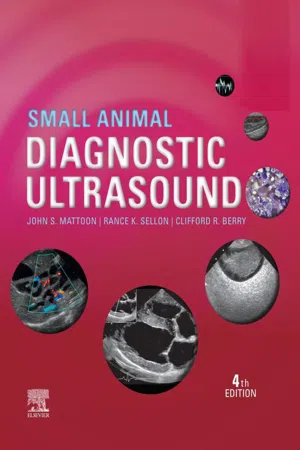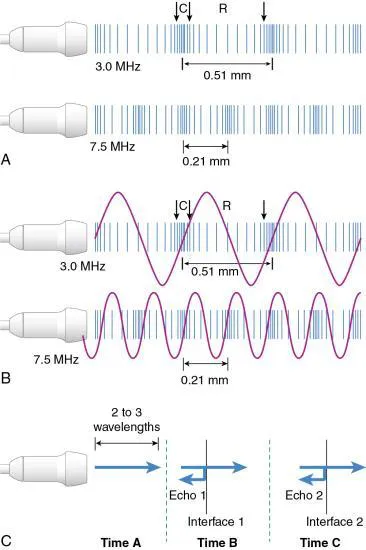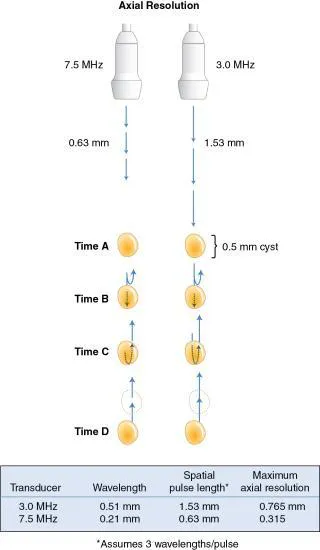Sound results from mechanical energy propagating through matter as a pressure wave, producing alternating compression and rarefaction bands of molecules within the conducting medium (Fig. 1.1). The distance between each band of compression or rarefaction is the sound’s wavelength (λ), the distance traveled during one cycle. Frequency is the number of times a wavelength is repeated (cycles) per second and is expressed in hertz (Hz). One cycle per second is 1 Hz; 1000 and 1 million cycles per second are 1 kilohertz (kHz) and 1 megahertz (MHz), respectively. The range of human hearing is approximately 20 to 20,000 Hz. Diagnostic ultrasound is characterized by sound waves with a frequency up to 1000 times higher than this range. Sound frequencies in the range of 2 to 15 MHz and higher are commonly used in diagnostic ultrasound examinations. Even higher frequencies (20 to 100 MHz) are used in special ocular, dermatologic, and microimaging applications.
Frequencies in the millions of cycles per second have short wavelengths (submillimeter) that are essential for high-resolution imaging. The shorter the wavelength (or higher the frequency), the better the resolution. Frequency and wavelength are inversely related if the sound velocity within the medium remains constant. Because sound velocity is independent of frequency and nearly constant (1540 m/sec) in the body’s soft tissues1,5 (Table 1.1), selecting a higher frequency transducer will result in decreased wavelength of the emitted sound, providing better axial resolution (see Fig. 1.1, A, and Fig. 1.2). The relationship between velocity, frequency, and wavelength can be summarized in the following equation:
TABLE 1.1
Velocity of Sound in Body Tissues
| Tissue or Substance | Velocity (m/sec) |
| Air | 331 |
| Fat | 1450 |
| Water (50°C) | 1540 |
| Average soft tissue | 1540 |
| Brain | 1541 |
| Liver | 1549 |
| Kidney | 1561 |
| Blood | 1570 |
| Muscle | 1585 |
| Lens of eye | 1620 |
| Bone | 4080 |
Data from Curry TS III, Dowdey JE, Murry RC Jr. Christensen’s Physics of Diagnostic Radiology. 4th ed. Philadelphia: Lea & Febiger; 1990.
The wavelengths for commonly used ultrasound frequencies can be determined by rearranging this equation (Table 1.2).
TABLE 1.2
Commonly Used Ultrasound Frequencies *
| Frequency (MHz) | Wavelength (mm) |
| 2.0 | 0.77 |
| 3.0 | 0.51 |
| 5.0 | 0.31 |
| 7.5 | 0.21 |
| 10.0 | 0.15 |
*Assume velocity = 1.54 mm/µsec (1540 m/sec).




